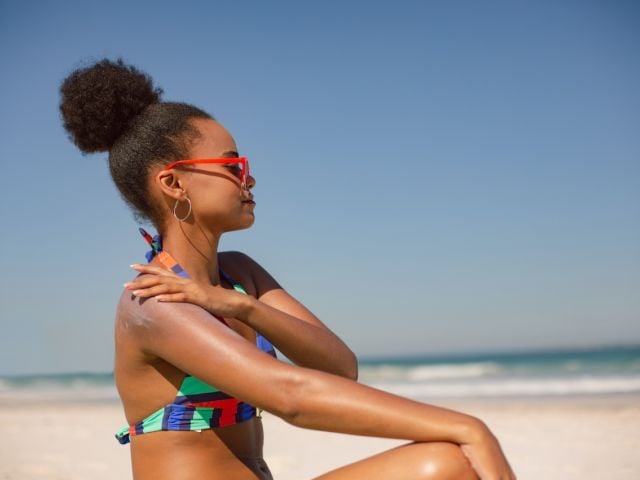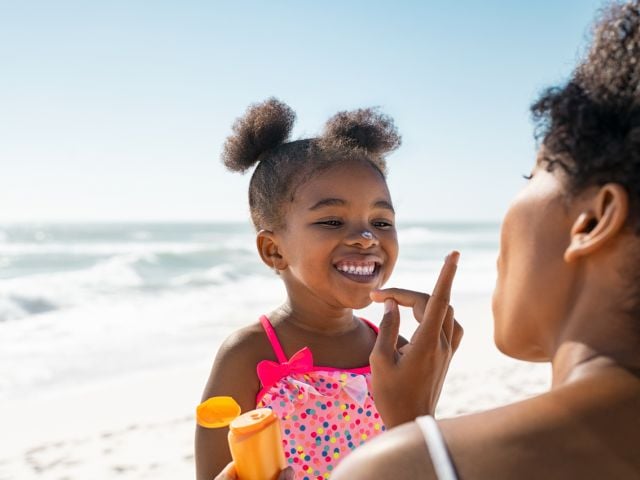
When it comes to protecting yourself from the sun, it's easy to go wrong. To help you go right, instead, we whipped up a list of the really bad actors because sometimes, knowing what's on the "avoid" list is a good way to land a safer product.
To that end, here are some prime examples of products that typify what's wrong with the sun protection business - and remember, don't buy them - or their marketing claims: 1. Banana Boat Baby Max Protect, SPF = 100 Sky-high SPF protects against sunburn but leaves skin exposed to damaging UVA rays.
One of at least 79 sunscreens on the market this year with high SPFs (greater than "SPF 50+"), this product protects babies from UVB radiation and the sunburns it causes but leaves them exposed to UVA radiation that penetrates deep into the skin. UVA is known to accelerate skin aging and cause skin cancer (IARC 2009).
A standard industry sunscreen model estimates that the actual UVA protection factor for this sunscreen is only 9.3 - a far cry from 100 (BASF 2010). The best possible UVA protection in U.S. sunscreen lotions is currently about 20 (BASF 2010). Sunscreen makers are waiting for the FDA to decide whether to approve a wider selection of chemicals that could help boost UVA protection. In the meantime, high-SPF products may tempt people to stay in the sun too long, suppressing sunburns but upping the risks of other kinds of skin damage. EWG recommends that consumers avoid products labeled with anything higher than "SPF 50+" and reapply sunscreen often, regardless of SPF.
2. iS Clinical SPF 20 Powder & Peter Thomas Roth Instant Mineral Powder SPF 30 Loose powder sunscreens can enter the airways and may move from the lungs to the bloodstream. Health concerns include cancer and tissue damage.
These sunscreens are in a loose powder form. The particles of zinc and titanium they contain can offer strong UV protection for the skin, but they end up in the lungs, too, inhaled from a cloud of airborne particles with each use. There, they can cause damage. The International Agency for Research on Cancer classifies inhaled titanium dioxide as "possibly carcinogenic to humans," based on studies of rats and of people who work in dusty environments (IARC 2006).
Once in the lungs, the minerals may move into the bloodstream and throughout the body. In 2008 a research group based in China reported that nanoscale titanium dioxide like that used in many sunscreens can accumulate in the brain and cause lesions and other tissue damage (Wang 2008). Nano and micronized zinc oxide cause lung inflammation (Sayes 2007).
The bottom line? Sunscreen belongs on your skin, not in your lungs. EWG recommends that people stick to creams and avoid powders, pumps and sprays.
3. Hawaiian Tropic Baby Creme Lotion SPF 50 "Advanced UVA protection"? Not so much. Many U.S. sunscreens claim to provide "broad spectrum" protection that blocks both UVA and UVB rays, but the reality is that they don't. Hawaiian Tropic Baby Creme Lotion SPF 50 lists "Advanced UVA protection" on its website and "UVB/SPF with UVA" on its label. But it would earn only 1 star in FDA's proposed 4 star UVA labeling scheme, according to EWG analysis using a standard industry sunscreen model.
Hawaiian Tropic is not required to back up its claim of "advanced UVA protection," and the fact is that no currently available sunscreen chemical has been shown to block UVA rays effectively. Regulations in Japan and Australia prohibit making such claims altogether for products that provide such weak UVA protection (Diffey 2009), but there is no such restriction in the U.S.
Based on a review of partial label information published by online retailers, EWG researchers identified 218 beach sunscreens that claim "broad spectrum" or "full spectrum" protection for 2010. Many would garner only "low" or "medium" UVA protection in FDA's proposed labeling system. 4. Aveeno Baby Continuous Protection SPF 55 "Mild as water." Sure it is. Can a product be "mild as water to the skin" if the label warns to "Stop use and ask a doctor if rash or irritation develops and lasts"? And certainly when swallowed this product is nothing like water: "Keep out of reach of children" and "get medical help or contact a Poison Control Center right away," reads the warning label.
5. Anthony Logistics for Men Sunstick SPF 15 Safe for eyes? Not really. This product's directions tell users to "Apply to eye area," but the warnings advise: "Keep out of eyes."
Since there are no regulations to ensure it, you would hope that common sense would lead sunscreen makers to formulate products for use around the eyes that are actually safe for the eyes. No such luck! Tip for consumers: Wear sunglasses and keep sunscreen (including from sprays) out of your eyes. 6. Panama Jack Naturals Baby Sunblock SPF 50 Potential hormone disruptor in baby sunblock. Panama Jack advises users of this baby product to "apply liberally."
Scientists who have researched a key sunscreen chemical in this sunblock, the potential hormone disruptor oxybenzone, advise the opposite: "It would be prudent not to apply oxybenzone to large surface areas of skin for extended and repeated periods of time, unless no alternative protection is available. There may be an additional concern for young children who have less well developed processes of elimination, and have a larger surface area per body weight than adults, with respect to systemic availability of a topically applied dose" (Hayden 1997).
This Panama Jack sunscreen is one of at least 26 sunscreens offered in the 2010 season with the word "baby" in their name and the chemical oxybenzone on their ingredient list. EWG advises consumers to avoid sunscreens containing oxybenzone. Plenty of safer products are available.
Oxybenzone is readily absorbed through the skin; government studies have detected the compound in 97 percent of the population (Calafat 2008). In rodents, it mimics estrogen and increases the weight of the uterus (Schlumpf 2004). In people, higher maternal exposures to oxybenzone have been linked to decreased birth weight in girls (Wolff 2008).
One more thing: This so-called "natural" sunscreen contains at least ten compounds that do not occur in nature. Most are made from petroleum.
7. Banana Boat Ultra Defense Sunscreen Stick SPF 50 "It doesn't break down," says the manufacturer of the Banana Boat sunscreen stick. Maybe it doesn't break down, but it also doesn't last forever.
You might think one coat would do you for a whole day. Not so. Even though sunscreen makers like Banana Boat often use stabilizing additives to keep their ingredients from breaking down in sunlight, the product still doesn't last forever on the skin. Sunscreens wash off in water and rub off on clothes and towels. Tip for sunscreen users: Some sunscreen chemicals break down in the sun. They also wash off in water and rub off on towels and clothes - reapply them as directed.
8. Baby Blanket Tender Scalps Scalp Sunscreen Spray for Babies SPF 45+
"Instantly provides 45 times your babies' natural protection," claims the manufacturer. More like: Instant protection from sunburn, instant exposure to UVA rays.
While that may be true for UVB rays and the red burns and blisters they cause, it's not the case for UVA. This product would earn only one of four stars for UVA protection in FDA's proposed rating system, according to EWG's analysis. Your baby's scalp may not get burned, but UVA rays could instantly penetrate deeply and cause skin damage and trigger cancer later in life. At least 18 other products EWG assessed claim "instant" or "immediate" protection.
If your sunscreen made it into our 2010 Hall of Shame, go ahead and find a better one by searching our online database.



